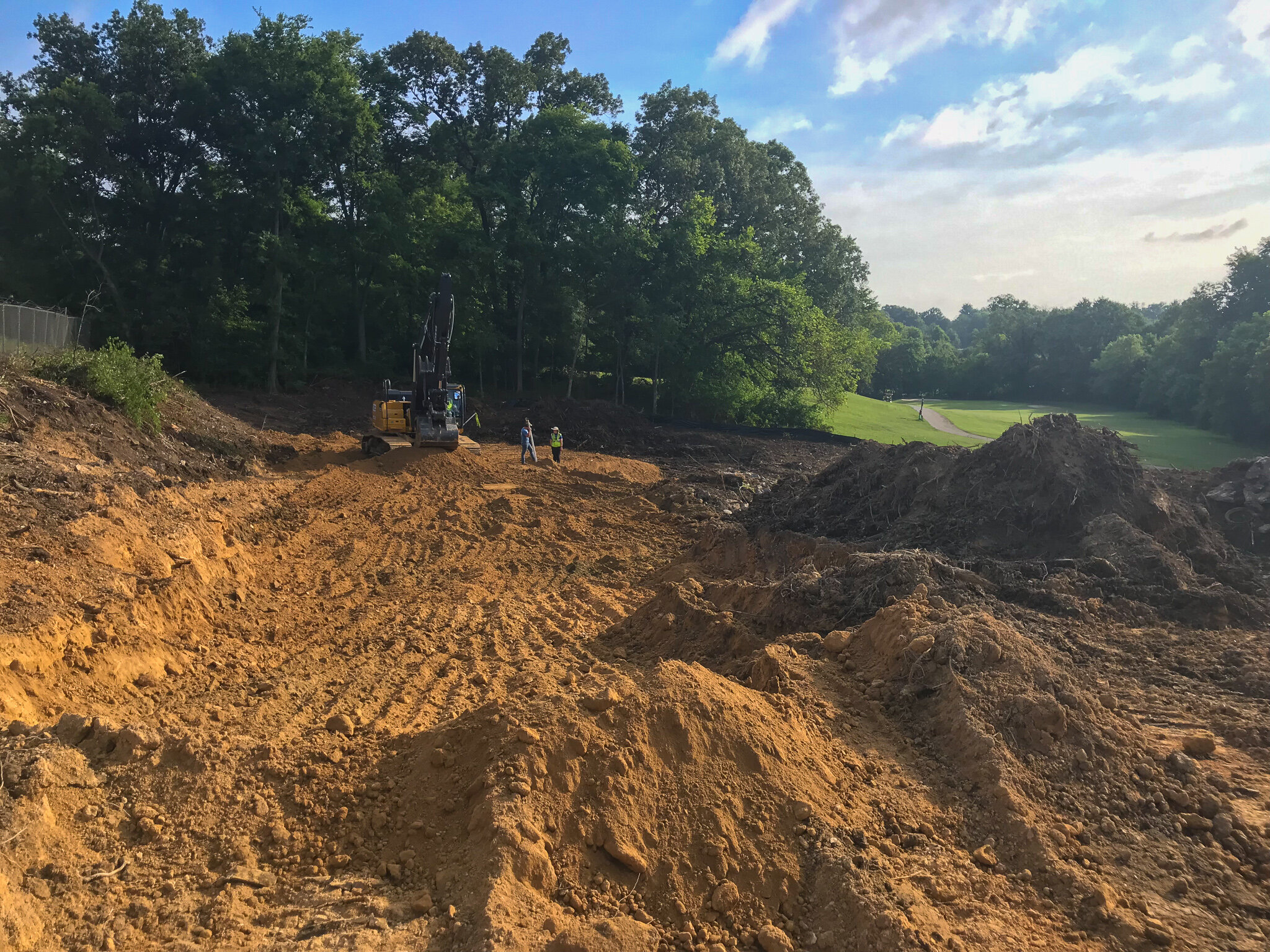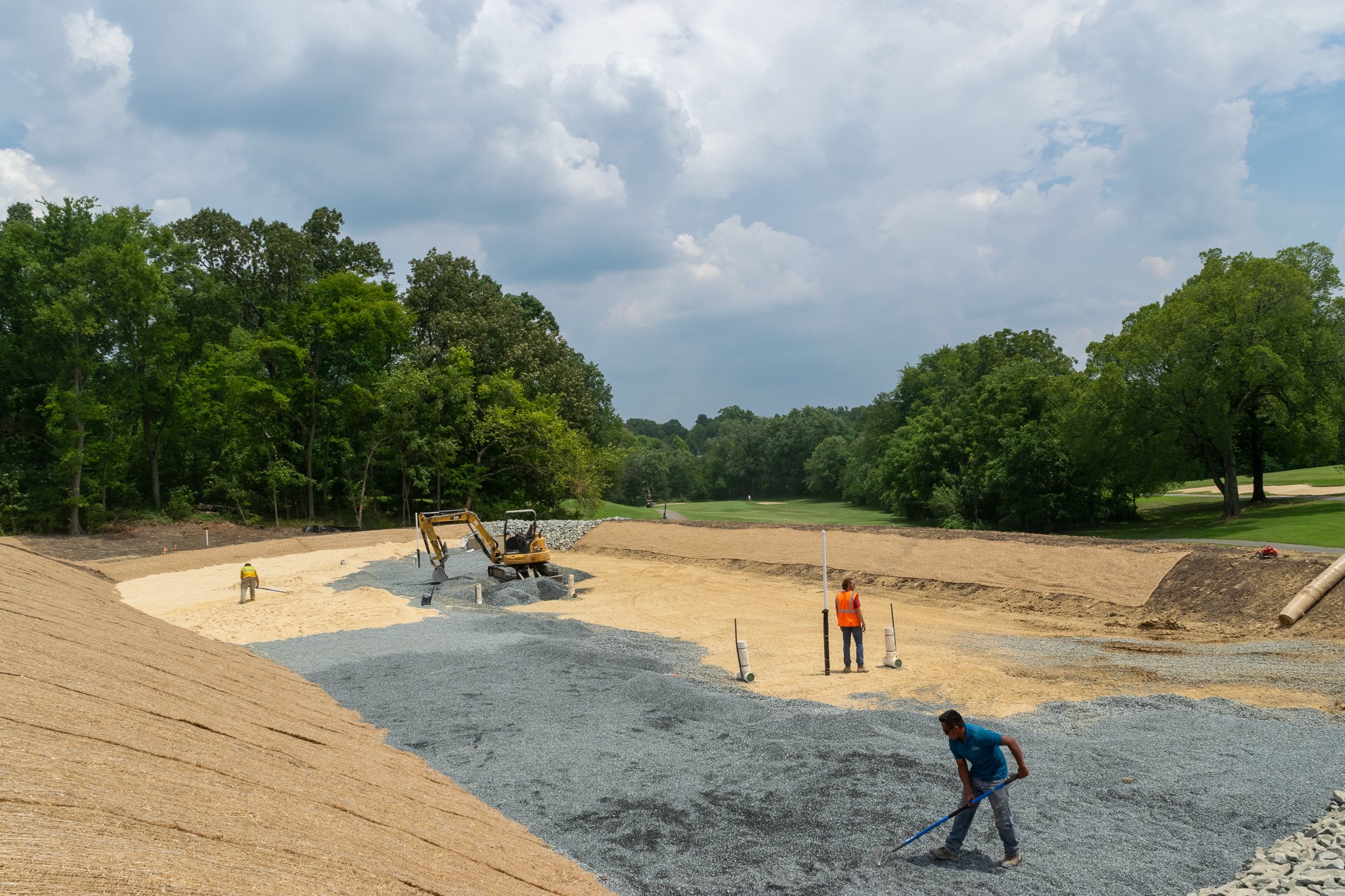Subsurface Gravel Wetland: Stormwater Management Innovation
Subsurface gravel wetlands are a highly effective, relatively recent innovation in stormwater management. In July 2019, Dragonfly Pond Works, lake and pond management contractor, constructed a subsurface gravel wetland designed by NC State Department of Biological and Agricultural Engineering (NC State BAE) in collaboration with the City of Greensboro and NC Clean Water Management Trust Fund sponsorship. The project is only the second stormwater gravel wetland in North Carolina and the first to be called a subsurface gravel wetland.
Subsurface gravel wetlands follow the look and function of natural wetlands. The main difference is that regular wetlands have a permanent pool of water on the surface, while subsurface gravel wetlands hold a reservoir of water below the surface in the subsurface gravel layer. Stormwater is filtered and treated as it flows through the subsurface layer. This layer creates an environment rich in microbes which increases nutrient removal. One of the NC State BAE design engineers, Sarah Waickowski, explained the system as a hybrid between a wetland and a bioretention cell. The innovative system is highly effective at removing nutrients, sediment, and other common stormwater runoff pollutants.
Existing system overgrown with vegetation.
The existing system on-site was overgrown. Additional obstacles included elevation changes of 15 feet and sitting between a golf course and an operations center where trash trucks are washed. The result of the ineffective system and an almost constant flow of water was unsatisfactory pollution filtration and golf course erosion. The main challenges in design and execution were solving the stormwater issue without impacting the golf course. The city and NC State BAE agreed it was an ideal location for North Carolina's first subsurface gravel wetland. Experienced pond management contractor, Dragonfly Pond Works, readily took on construction.
Subsurface Gravel Wetland: Construction
Dragonfly Pond Works begins clearing the overgrown vegetation.
Photograph: NC State BAE
On day three, HoneyBell's Bee Farm came in to help save and relocate honeybees on site. Honeybees can build nests in existing tree cavities, which they had done here. Thanks to the chain saw expertise of Dragonfly Regional Manager, James Wehbie, and the vast knowledge of HoneyBell's Bee Farm, many honeybees were saved!
Dragonfly, James Wehbie, and HoneyBell's Bee Farm.
Photograph: NC State BAE
After clearing the site.
Photograph: NC State BAE
Following the clearing, the grading phase of the subsurface gravel wetland began. The area of the wetland bottom was excavated and the dam was constructed. The crew graded the forebay and built the forebay berm. Throughout this process, a compactor ensured proper compaction and soil compaction tests were administered.
Photograph: NC State BAE
Final Grading
Photograph: NC State BAE
The Dragonfly crew excavates the forebay and forebay berm of the subsurface gravel wetland.
The riser is installed around the existing reinforced concrete pipe.
PVC drain pipes were installed before sand and gravel backfill. The PVC pipes facilitate the movement of stormwater through the subsurface gravel wetland.
Installation of Crushed Stone and Concrete Sand
Crushed stone (subsurface gravel layer) is placed over the wetland bottom. Our stormwater experts layer and grade the crushed stone throughout the subsurface gravel wetland.
The forebay is in the foreground and the wetland bottom in the background. The golf course is visible to the right.
A layer of concrete sand is installed on top of the subsurface layer of crushed stone.
Separation fabric was installed around the inlets and forebay berm. The crew then paced rip rap, or rock, over the fabric to protect against erosion.
Topsoil and compost mix were spread on top of the fill dirt on the dam, side slope, and forebay berm.
The Dragonfly crew then seeded and stabilized the area. Grass will be established.
Construction is complete and the system successfully handled the first major rain event!
Since completion of the subsurface gravel wetland, NC State planted 56 shrubs and 1,100 herbaceous plugs. NC State BAE will continue to monitor the system. Dragonfly Pond Works is proud to have been able to construct the first subsurface gravel wetland in North Carolina in collaboration with NC State Department of Biological and Agricultural Engineering and the City of Greensboro. Contact us to learn how we can help you create and maintain a beautiful space.
Learn More!
Learn more about our Pond Management services. Low-impact dredging revives this community pond!
Like/Follow us on Facebook, Twitter, Instagram, and LinkedIn.
In addition to subsurface gravel wetland construction, Dragonfly Pond Works provides stormwater management, lake and pond management, and more in Raleigh, Durham, Cary, Charlotte, Wilmington, North Carolina, Myrtle Beach, Charleston, Columbia, South Carolina, Tampa, Sarasota, Naples, St. Petersburg, Fort Myers, Florida, and Atlanta, Georgia.
Special thanks to NC State BAE and Sarah Waickowski, City of Greensboro, NC Clean Water Management Trust Fund, and HoneyBell's Bee Farm. Additional content provided by Dragonfly Regional Manager, James Wehbie. (Click on words in bold to learn more about the organizations.)




















